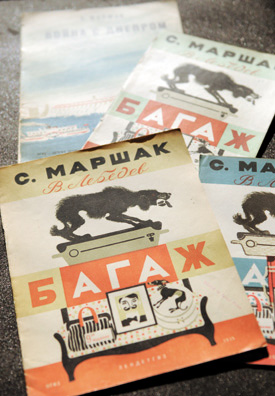The people’s literature
By Shira Tevah, ’09
Photography by Dan Dry

In 1930s Soviet Russia, children’s books and wartime propaganda had a lot in common. Both genres fell along a “continuum from literature for children to the high ideology” that characterized the Soviet state, says Slavic languages & literature associate professor Robert Bird. Along with art-history professor Matthew Jesse Jackson and six graduate students, Bird has studied 500 Soviet children’s books housed in the Regenstein Library’s Special Collections Research Center. Unofficially regulated by the government, the books almost always flattered the state, Bird says, and depicted “total rationalization of nature.” Soviet institutions became a frequent focus: transportation, electricity, libraries. The books credited the 1917 Bolshevic Revolution for modernizing the country and making way for a better life.
Featuring a train emblazoned with the hammer and sickle, Somuil Marshak’s War with the Dnieper (a river running from Russia through Belarus and the Ukraine) uses typically heroic language. It begins, according to Bird’s translation: “Man said to the Dnieper: I will close you with an iron wall / You will jump from the heights and you will move machines / They declared war on the river / War, war, war!” It ends, “Water will push trains / Electricity will move the plow across the land and light the houses.”
The books are colorful and abstract with featureless faces—an artistic style that accompanied Soviet collectivization, Bird explains. All are “subtly keyed in to networks” like trains and libraries. It might not seem noteworthy, he says, but “it wasn’t just media”—the Soviet Union also had a “totalizing political culture.”
